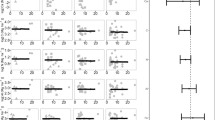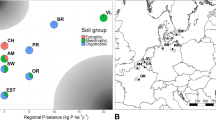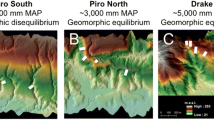Abstract
The role of secondary vegetation in restoring soil fertility during shifting cultivation in the tropics is well known. Yet the effect of secondary succession on the spatial patterns of soil properties has received little attention. To determine whether changes in the plant community as a result of shifting cultivation affect the scale of spatial dependence for biologically important soil nutrients, we sampled three dry tropical forest stands in Campeche, Mexico. These stands represented a gradient of cultivation history: one mature forest stand, a forest fallow that had undergone one cultivation-fallow cycle, and a forest fallow that had undergone two cultivation-fallow cycles. We used an analysis of semivariance to quantify the scale and magnitude of spatial dependence for organic matter content (OM), phosphorus (P), potassium (K), and aluminum (Al) in each stand. The scale of spatial dependence varied with cultivation history, but the degree of spatial dependence did not differ among stands. In the mature forest P and K were autocorrelated over distances >7.5 m. In the forest fallows 48–88% of the variation in soil P and K was autocorrelated over distances up to 1.1–5.1 m. In contrast, the range of autocorrelation for Al (∼2.5 m) did not differ among stands. We conclude that shifting cultivation changes the range of autocorrelation for biologically important soil nutrients at a scale that may influence plant growth. The finer scaled pattern of soil nutrients in forest fallows is likely to persist with continued shifting cultivation, since fallows are cleared every 3–15 years.




Similar content being viewed by others
References
Aber JD, Melillo JM (2001) Terrestrial ecosystems. Hardcourt Academic Press, New York
Blair BC (2005) Fire effects on the spatial patterns of soil resources in a Nicaraguan wet tropical forest. J Trop Ecol 21:435–444
Blair BC, Perfecto I (2004) Successional status and root foraging for phosphorus in seven tropical tree species. Can J For Res 34:1128–1135
Boettcher SE, Kalisz PJ (1990) Single-tree influence on soil properties in the mountains of eastern Kentucky. Ecology 71:1365–1372
Brady NC, Weil RR (1999) The nature and properties of soils 12th edn. Prentice-Hall, Inc., Upper Saddle River, NJ
Brown S, Lugo AE (1990) Tropical secondary forests. J Trop Ecol 6:1–32
Campo J, Maass JM, Jaramillo VJ, Yrízar AM (2000) Calcium, potassium, and magnesium cycling in a Mexican tropical dry forest ecosystem. Biogeochemistry 49:21–36
Campo J, Maass JM, Jaramillo VJ, Yrízar AM, Sarukhán J (2001) Phosphorus cycling in a Mexican tropical dry forest ecosystem. Biogeochemistry 53:161–179
Day KJ, Hutchings MJ, John EA (2003) The effects of spatial pattern of nutrient supply on yield, structure and mortality in plant populations. J Ecol 91:541–553
De Vos B, Vandecasteele B, Deckers J, Muys B (2005) Capability of loss-on-ignition as a predictor of total organic carbon in non-calcareous forest soils. Commun Soil Sci Plant Anal 36:2899–2921
Døckersmith IC, Giardina CP, Sanford RL Jr (1999) Persistence of tree related patterns in soil nutrients following slash-and-burn disturbances in the tropics. Plant Soil 209:137–156
Eaton JM, Lawrence D (2006) Woody debris stocks and fluxes during succession in a dry tropical forest. Forest Ecol Manage232:46–55
Fernandes DN, Sanford RL Jr (1995) Effects of recent land-use practices on soil nutrients and succession under tropical wet forest in Costa Rica. Conserv Biol 9:915–922
Frogbrook ZL, Oliver MA (2001) Comparing the spatial predictions of soil organic matter determined by two laboratory methods. Soil Use Manage 17:235–244
Gallardo A (2003) Spatial variability of soil properties in a floodplain forest in northwest Spain. Ecosystems 6:564–576
Gonzalez OJ, Zak DR (1994) Geostatistical analysis of soil properties in a secondary tropical dry forest, St. Lucia, West Indies. Plant Soil 163:45–54
Gross KL, Pregitzer KS, Burton AJ (1995) Spatial variation in nitrogen availability in three successional plant communities. J Ecol 83:357–367
Holmes KW, Kyriakidis PC, Chadwick OA, Soares JV, Roberts DA (2005) Multi-scale variability in tropical soil nutrients following land-cover change. Biogeochemistry 74:173–203
Huante P, Rincon E, Chapin FS III (1995) Responses to phosphorus of contrasting successional tree-seedling species from the tropical forest of Mexico. Funct Ecol 9:760–766
Jenny H (1941) Factors of soil formation. McGraw-Hill, New York
Jobbágy EG, Jackson RB (2001) The distribution of soil nutrients with depth: global patterns and the imprint of plants. Biogeochemistry 53:51–77
Kaluzny SP, Vega SC, Cardoso TP, Shelly AA (1998) S+ Spatial Stats user’s manual for Windows and Unix. Springer, New York
Keys E (2005) Market intermediaries link farms to markets: southeastern Mexican examples. Geogr Rev 95:24–46
Klepeis PJ (2004) Forest extraction to theme parks: the modern history of land change. In: Turner BL II, Geoghegan J, Foster DR (eds) Integrated land-change science and tropical deforestation in the Southern Yucatan: final frontiers. Oxford University Press, Oxford
Lawrence D, Suma V, Mogea JP (2005) Change in species composition with repeated shifting cultivation: limited role of soil nutrients. Ecol Appl 15:1952–1967
Lawrence D (2003) The response of tropical tree seedlings to nutrient supply: meta-analysis for understanding a changing tropical landscape. J Trop Ecol 19:1–12
Lawrence D, Foster DR (2002) Changes in forest biomass, litter dynamics and soils following shifting cultivation in southern Mexico: an overview. Interciencia 27:400–408
Lechowicz MJ, Bell G (1991) The ecology and genetics of fitness in forest plants. II. Microspatial heterogeneity of the edaphic environment. J Ecol 79:687–696
Markewitz D, Richter DD (1998) The bio in aluminum and silicon geochemistry. Biogeochemistry 42:235–252
Nye PH, Greenland DJ (1960) The soil under shifting cultivation. Technical Communication Number 51, Commonwealth Bureau of Soils, Harpenden, UK
Ping JL, Dobermann A (2006) Variation in the precision of soil organic carbon maps due to different laboratory and spatial prediction methods. Soil Sci 171:374–387
Read L, Lawrence D (2003) Recovery of biomass following shifting cultivation in dry tropical forests of the Yucatan. Ecol Appl 13:85–97
Robertson GP, Gross KL (1994) Assessing the heterogeneity of belowground resources: quantifying pattern and scale. In: Caldwell MM, Pearcy RW (eds) Exploitation of environmental heterogeneity by plants. Academic Press, New York
Robertson GP, Crum JR, Ellis BG (1993) The spatial variability of soil resources following long-term disturbance. Oecologia 96:451–456
Rossi RE, Mulla DJ, Journel AG, Franz EH (1992) Geostatistical tools for modeling and interpreting ecological spatial dependence. Ecol Monogr 62:277–314
Schlesinger WH (1997) Biogeochemistry: an analysis of global change. Academic Press, San Diego
Schlesinger WH, Raikes JA, Hartley AE, Cross AF (1996) On the spatial pattern of soil nutrients in desert ecosystems. Ecology 77:364–374
Stark JM (1994) Causes of soil nutrient heterogeneity at different scales. In: Caldwell MM, Pearcy RW (eds) Exploitation of environmental heterogeneity by plants. Academic Press, New York
Turner BL II (1974) Prehistoric intensive agriculture in the Mayan lowlands. Science 185:118–124
Turner BL II, Villar SC, Foster D, Geoghegan J, Keys E, Klepeis P, Lawrence D, Mendoza PM, Manson S, Ogneva-Himmelberger Y, Plotkin AB, Schneider L, Schmook B, Vance C (2001) Deforestation in the southern Yucatan peninsular region: an integrative approach. Forest Ecol Manage154:353–370
Varvel GE, Leibig MA, Doran JW (2002) Soil organic matter assessments in a long-term cropping study. Commun Soil Sci Plant Anal 33:2119–2130
Vester HFM, Lawrence D, Eastman JR, Turner BL II, Calmé S, Dickson R, Pozo C, Sangermano F (2007) Land change in the Southern Yucatán and Calakmul biosphere reserve: implications for habitat and biodiversity. Ecol Appl (in press)
Wijesinghe DK, John EA, Hutchings MJ (2005) Does pattern of soil resource heterogeneity determine plant community structure? An experimental investigation. J Ecol 93:99–112
Vitousek PM, Sanford RL Jr (1986) Nutrient cycling in moist tropical forest. Ann Rev Ecol Syst 17:137–167
Webster R (1985) Quantitative spatial analysis of soil in the field. Adv Soil Sci 3:1–70
Acknowledgements
We would like to thank the farmers of El Refugio for use of their land and their assistance in the field; Howie Epstein for his comments on an earlier draft of this paper; colleagues at ECOSUR for their logistical support; and the California Rangeland and the California Archaeology Laboratories for use of their computing facilities. For their assistance collecting and processing samples we thank Lee Panich and Cristin O’Connor. This paper has also benefited from the comments of two anonymous reviewers. This research is a product of the Southern Yucatán Peninsular Region (SYPR) project involving Clark University, University of Virginia, El Colegio de la Frontera Sur, and Harvard University. Its principal sponsors have been NASA-LCLUC (Land Cover and Land Use Change) program (NAG5-6046 and NAG5-11134), Center for Integrated Studies of the Human Dimensions of Global Environmental Change, Carnegie Mellon University (NSF SBR 95-21914), and NSF-Biocomplexity (BCS-0410016). This research was also supported by a Terrence Daniels Family Jefferson Graduate Fellowship from the University of Virginia.
Author information
Authors and Affiliations
Corresponding author
Appendix
Appendix
Appendix 1. Lag interval, minimum and maximum number of pairs, and lag distance at which they occur for each variogram
Site | Lag interval (cm) | Minimum number of pairs | Maximum number of pairs | ||
|---|---|---|---|---|---|
np | Lag distance (cm) | np | Lag distance (cm) | ||
Organic matter | |||||
Mature (0°) | 30 | 15 | 602 | 30 | 31 |
(90°) | 30 | 11 | 571 | 30 | 119 |
Mature (0°) | 30 | 10 | 359 | 23 | 239 |
(90°) | 30 | 14 | 600 | 35 | 88 |
One-fallow | 45 | 19 | 16 | 197 | 630 |
One-fallow | 30 | 56 | 30 | 111 | 600 |
Two-fallow | 26 | 46 | 27 | 99 | 493 |
Two-fallow | 34 | 10 | 12 | 151 | 645 |
Phosphorus | |||||
Mature | 50 | 37 | 49 | 92 | 650 |
Mature | 30 | 44 | 60 | 112 | 689 |
One-fallow (0°) | 40 | 11 | 15 | 77 | 519 |
(90°) | 40 | 23 | 159 | 58 | 720 |
One-fallow | 35 | 7 | 14 | 157 | 699 |
Two-fallow | 22 | 35 | 23 | 82 | 440 |
Two-fallow | 25 | 40 | 27 | 91 | 675 |
Potassium | |||||
Mature (0°) | 32 | 18 | 576 | 34 | 32 |
(90°) | 32 | 11 | 575 | 26 | 93 |
Mature | 28 | 43 | 56 | 94 | 531 |
One-fallow | 40 | 18 | 15 | 172 | 681 |
One-fallow | 50 | 24 | 19 | 220 | 699 |
Two-fallow | 40 | 12 | 14 | 169 | 720 |
Two-fallow | 25 | 9 | 12 | 138 | 649 |
Aluminum | |||||
Mature (0°) | 20 | 12 | 381 | 21 | 119 |
(90°) | 25 | 12 | 398 | 28 | 123 |
Mature | 40 | 22 | 15 | 127 | 400 |
One-fallow | 50 | 20 | 16 | 216 | 700 |
One-fallow | 35 | 7 | 14 | 157 | 699 |
Two-fallow (0°) | 45 | 10 | 17 | 46 | 89 |
(90°) | 45 | 11 | 16 | 49 | 90 |
Two-fallow | 38 | 7 | 11 | 131 | 646 |
Rights and permissions
About this article
Cite this article
Diekmann, L.O., Lawrence, D. & Okin, G.S. Changes in the spatial variation of soil properties following shifting cultivation in a Mexican tropical dry forest. Biogeochemistry 84, 99–113 (2007). https://doi.org/10.1007/s10533-007-9107-1
Received:
Accepted:
Published:
Issue Date:
DOI: https://doi.org/10.1007/s10533-007-9107-1




